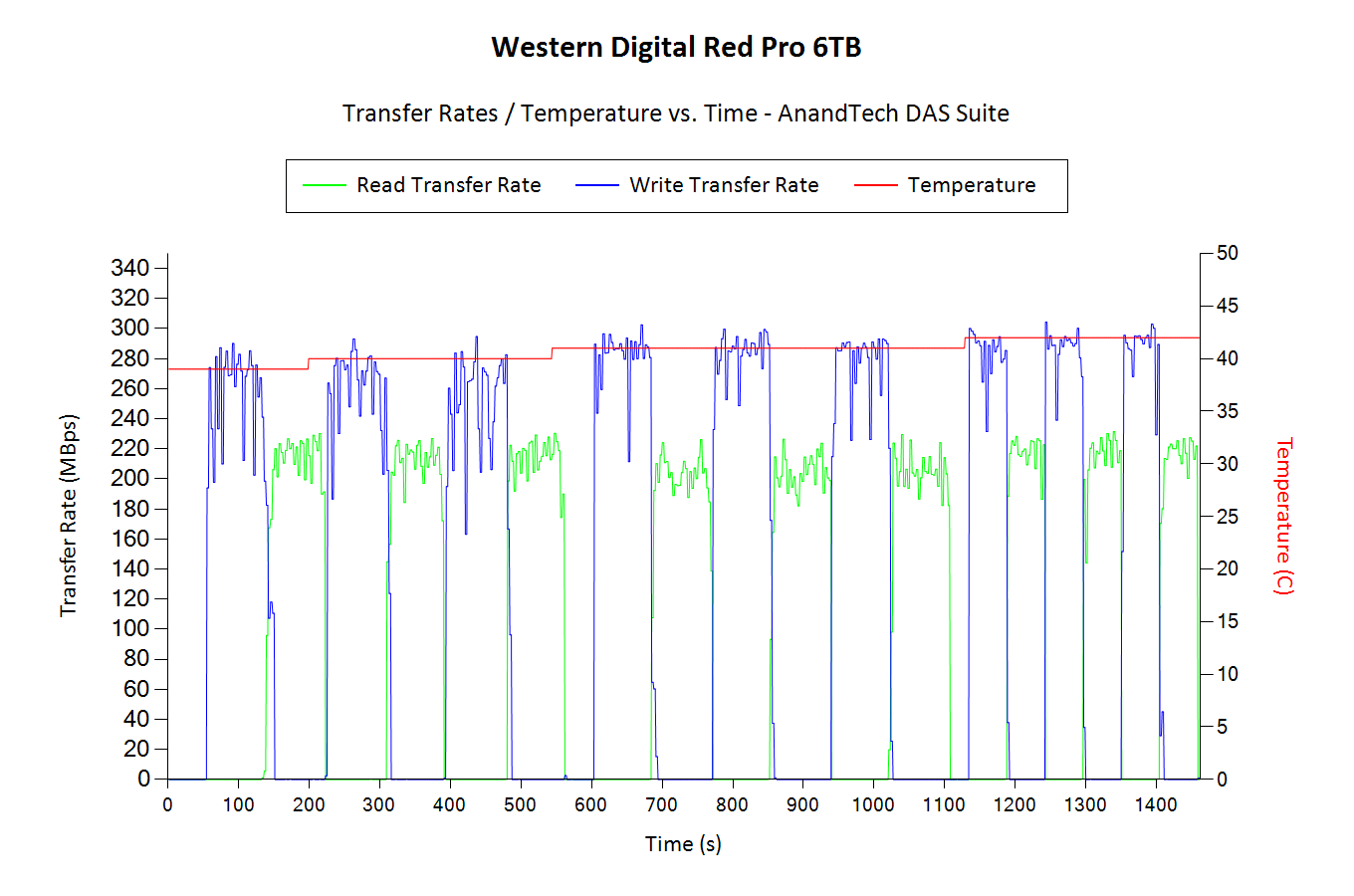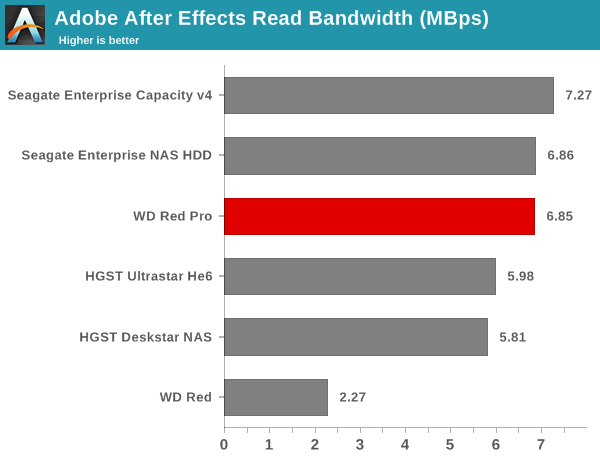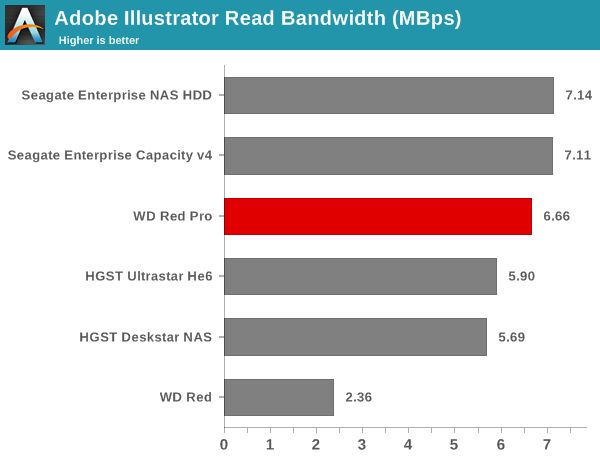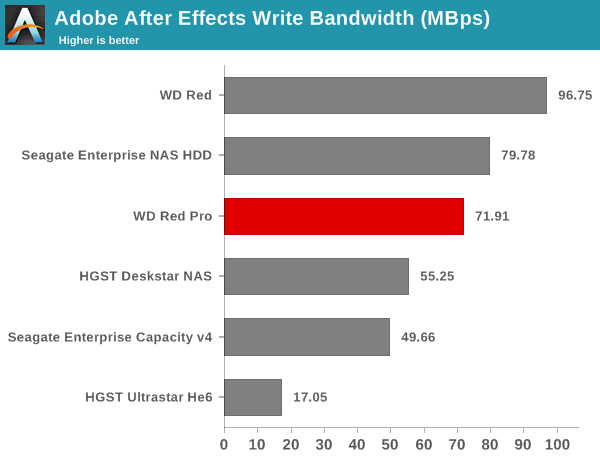WD Red Pro 6 TB Review - High Performance NAS HDD Gets a Capacity Bump
by Ganesh T S on September 7, 2015 8:00 AM EST- Posted in
- NAS
- Storage
- HDDs
- Western Digital
Single Client Access - DAS Benchmarks
The WD Red Pro was connected to a 6 Gbps SATA port off the PCH in our DAS testbed. After formatting in NTFS, it was subject to our DAS test suite. While processing our DAS suite, we also recorded the instantaneous transfer rates and temperature of the drive. Compared to other NAS drives at the same capacity point, write transfers show higher instantaneous speeds due to a combination of the firmware and the 128 MB cache inside the disk. However, sustained write rates are comparable to other 6TB drives. The temperature of the unit at the end of the transfers, despite being blow 45C, is higher than any of the other drives at the same capacity point.

The graphs below present the average transfer rates for the various workloads and how they compare against other HDDs of the same capacity that have been evaluated before.






PCMark 8 Storage Traces








In the real-life workloads, the caching behavior enables the WD Red Pro to score better than the competitors in almost all the write tests. Read scenarios show it coming in the middle of the pack.










62 Comments
View All Comments
MHz Tweaker - Wednesday, September 9, 2015 - link
My findings are that Backblaze statistics are RIGHT on target. In fact they may be too kind to Seagate. I threw 12 Seagate drives in the trash this spring that were 1.5, 2 and 3TB capacities with 3tb drives being the worst drives I have ever come in contact with. I would say that my 3TB Seagate drive failures are higher than 75% in 24 months. I own a service and repair company and observe Seagate drives fail in droves, particularly the 3TB ones. Seagate 4tb drives are vastly more reliable so far but I stopped buying Seagate drives PERIOD because of the thousands of dollars I lost dealing with them. My primary drive is HGST now. I have a couple dozen of their 4, 5 and 6TB NAS drives in a pair of Win 2012R2 servers and a X99 Workstation. I also use them in client servers and workstations for backup images. In 3 years I have yet to have a HGST drive fail or even receive a D.O.A. Great drives.Wwhat - Monday, September 7, 2015 - link
Formerly know as 'deathstar' when still owned by IBM due to consistent early failure, I don't get that they didn't change the name.Personally I don't trust 'consumer reviews' blindly, because there is massive cheating with paid fake reviews on the internet, and because each person has its own usage pattern and perhaps a good experience with a brand is based on a use quite dissimilar to mine.
melgross - Monday, September 7, 2015 - link
I only recall IBM having one particular drive that had a problem. Long time ago, and I don't remember the model, but it was a 75GB unit.bigboxes - Monday, September 7, 2015 - link
I had 6 of those 60GB "Deathstar" drives and each and every one of them eventually failed with the "click of death". I was able to RMA them under warranty and every one failed except for one which is sitting in a box somewhere.bigboxes - Monday, September 7, 2015 - link
75GXP and 60GXP were the bad models.Samus - Monday, September 7, 2015 - link
^ this. The first-generation giant magneto resistant (GMR) heads were not reliable. This hasn't been an issue for a decade. IBM/Hitachi/HGST-Toshiba has changed hands so many times (not owned by WD) that very little IBM technology, if any at all, remains in these new drives.Wwhat - Wednesday, September 9, 2015 - link
I posted my deahtstar remark as a reply to a comment about the deskstar, and am aware it's not a WD company.I have no idea why it did not show up as a reply, probably the poorly codedantiquated comment system to blame?
And my primary point is that it's odd that the company changed name twice but they kept that name with which people had bad memories, it's simply a weird thing to do.
Samus - Thursday, September 10, 2015 - link
It's a pretty good name. The same reason Ford brought back the Taurus nameplate. Even though it was associated with a crappy product at the end of its run, it still has good history behind it.Kjella - Tuesday, September 8, 2015 - link
The IBM Deskstar 75GXP series, but it had six models with 15/20/30/45/60/75GB capacity. Personally I had a 45GB drive die to the "click of death".Souka - Tuesday, September 8, 2015 - link
I think I had a number of these drives....they were the fastest around (or most performance per$$)